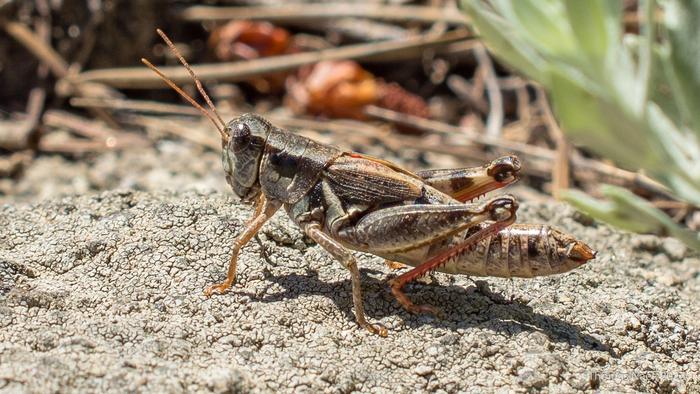In a world grappling with the decline of insect populations, scientists are racing against time to decode the impacts of climate change on these crucial components of our ecosystem. Recent research focusing on Colorado grasshoppers delivers intriguing insights. Contrary to the belief that climate change universally shrinks species sizes to cope with elevated temperatures, this study reveals a complex tapestry of responses that will significantly impact our understanding of ecological dynamics under ongoing climate shifts.
The groundwork for this groundbreaking research began decades ago, with the meticulous collection of 13,000 grasshopper specimens atop a Colorado mountain by biologist Gordon Alexander during the late 1950s. This critical dataset lay dormant for many years following Alexander’s tragic death in a plane crash in 1973. It was not until 2005 that postdoctoral fellow César Nufio resurrected this repository of knowledge, recognizing its potential to illuminate the intricate interactions between climate change and insect physiology.
Nufio led a new survey to gather contemporary samples from the same sites where Alexander had once worked. This initiative illuminated the evolutionary legacy of environmental change by comparing findings from over half a century past with those of today. Collaborating with fellow biologists from esteemed institutions, including Caroline Williams at UC Berkeley and Lauren Buckley at the University of Washington, the team investigated the size variations in several grasshopper species and how these alterations relate to climate fluctuation and seasonal timing.
The findings published in the journal PLOS Biology shed light on a remarkable phenomenon: while climate change has instigated size reductions in some grasshopper species, others have adapted by growing larger. This paradox is principally observed among the nymphal diapausers—grasshoppers that spend winter in a juvenile state and can commence feeding earlier in the spring. This early start enables them to thrive on the lush greenery that emerges with the thawing of winter. Conversely, the egg diapausers, hatching in the spring from eggs laid in the fall, have shown a substantial decline in size, likely due to deteriorating vegetation and altered growth patterns.
Williams and her colleagues methodically analyzed factors like elevational gradients, timing of life stages, and historical records of environmental conditions to draw their conclusions. Their projections hinted at varying fates for different species, driven by their ecological niches and life cycles. This research reiterates the importance of nuanced understanding in ecological forecasting, highlighting that outcomes can shift within species depending on environmental contexts.
Surprisingly, as climatic conditions worsen, nymphal diapausers thrived at lower elevations, where warmer summers provided ample resources. Yet, life was harsher for the grasshoppers hatching from eggs at higher altitudes. Data from the study suggests that, in these conditions, larger snowcaps may inhibit early food production, stunting growth. Therefore, the researchers emphasize that the challenge of predicting the consequences of climate change on individual species requires a multidimensional approach that takes into account various factors including temperature variability and elevation.
This innovative research utilizes the invaluable historical specimens from museum collections, allowing scientists to make direct comparisons over time without the interruptions caused by shifts in land use or experimental methodologies. The results of this study may serve as a beacon for future research, demonstrating that well-curated historical data can provide essential context for understanding current biodiversity trends.
In a broader context, the study’s findings resonate with observations across multiple species, including other invertebrates and vertebrates. Buckley points out that similar size adaptations have been noted in butterfly populations, implying that the principles gleaned from grasshopper studies could extend to other species facing climate pressures. This cross-species consistency enhances the predictive capabilities of ecologists striving to assess the broader implications of climate change on ecosystems.
Continued collaboration among the researchers is vital as they delve deeper into the metabolic, biochemical, and genetic adaptations associated with size variation in the face of climate change. Their work exemplifies the vital intersection of evolutionary biology, ecology, and climate science, necessitating interdisciplinary dialogue to address the pressing challenges posed by environmental transformation.
As this research unfolds, the implications of its findings beckon urgent action. Predicting which species may adapt successfully and which may falter remains a formidable task. Yet, through dedicated studies grounded in historical data and ecological principles, the door opens for more informed conservation strategies that could mitigate the impacts of climate change on biodiversity.
Success in these endeavors may not only illuminate the shadows cast by climate change on current ecosystems but also equip future generations of biologists and ecologists with the tools they need to navigate the uncertainties ahead. The challenge remains, but through careful examination of the past and an eye toward future possibilities, researchers can strive to design resilient ecosystems capable of withstanding the pressures of our warming world.
The legacy of Gordon Alexander’s collection serves as both a reminder of the value of meticulous scientific work and as an inspiration for future studies. Each grasshopper tells a story not only of its species but of an entire ecosystem adapting to a dynamic environment. As climatic forces continue to reshape our world, such research may prove crucial for understanding the myriad responses of life on Earth.
Subject of Research: Animals
Article Title: Insect size responses to climate change vary across elevations according to seasonal timing
News Publication Date: 30-Jan-2025
Web References: DOI Link
Image Credits: Credit: Thomas Naef, 2022
Keywords: Climate Change, Grasshoppers, Insect Size, Colorado, Adaptation, Biodiversity, Ecology, Evolution, Metabolic Response, Seasonal Timing, Museum Collections, Conservation.
Tags: biodiversity and climate adaptationCésar Nufio’s contributions to entomologyclimate change and insect life cyclesColorado grasshopper researchecological dynamics under climate shiftsenvironmental change and insect physiologyevolutionary responses of grasshoppersGordon Alexander’s research legacyhistorical insect specimen analysisimpacts of climate change on insectsinsect population declinelong-term ecological studies





